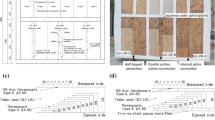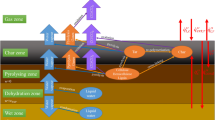Abstract
Fire safety has always been a major concern in the design of timber construction. Even though wood is a highly combustible material, timber members can perform adequately under elevated temperatures. The thermal response of timber connections, however, is in most cases poor and determination of their fire resistance is usually the crucial factor in evaluating the overall load-bearing capacity of wood structures exposed to fire. The analysis of timber joints under fire conditions can be challenging due to their complexity and variety. After presenting the variation of the properties of timber with temperature, this paper reviews the fire performance of various connection types, such as bolted or nailed wood-to-wood and steel-to-timber joints. Results from relevant experimental programs and numerical studies are discussed in detail and future research needs are highlighted. The effect of several factors on the fire resistance of timber connections, such as the fastener diameter, timber thickness and joint geometry, is investigated and useful conclusions are drawn. Based on these, preliminary guidelines for the efficient design of timber connections under fire exposure are presented.

















Similar content being viewed by others
References
ISO 834-1 (1999) Fire-resistance tests—elements of building construction—part 1: general requirements. ISO, Switzerland
CAN/ULC-S101-07 (2007) Standard methods for fire endurance tests of building construction and materials. Laboratories of Canada, Ottawa
Mehaffey JR, Cuerrier P, Carisse G (1994) A model for predicting heat transfer through gypsum board/wood stud walls exposed to fire. Fire Mater 18:297–305. doi:10.1002/fam.810180505
Janssens ML (1994) Thermo-physical properties for wood pyrolysis models. In: Pacific timber engineering conference, Gold Coast, Australia
Knudson RM (1973) Performance of structural wood members exposed to fire. PhD dissertation, University of California, Berkeley, USA
Fredlund B (1993) Modelling of heat and mass transfer in timber structures during fire. Fire Saf J 20:39–69
Konig J, Walleij L (2000) Timber frame assemblies exposed to standard and parametric fires, part 2: a design model for standard fire exposure. Rapport I 0001001. Swedish Institute for Wood Technology Research, Stockholm
Lie TT (1992) Structural fire protection. ASCE manuals and reports of engineering practice, no. 78. American Society of Civil Engineers, New York
Takeda H, Mehaffey JR (1998) WALL2D: a model for predicting heat transfer through wood-stud walls exposed to fire. Fire Mater 22:133–140
EN 1995-1-2 (2009) Eurocode 5—design of timber structures part 1–2: general rules—structural fire design. CEN, Brussels
Peng L, Hadjisophocleous G, Mehaffey J, Mohammad M (2011) Predicting the fire resistance of wood–steel–wood connections. Fire Technol 47:1101–1119. doi:10.1007/s10694-009-0118-4
EN 1993-1-2 (2005) Eurocode 3—design of steel structures part 1–2: general rules—structural fire design. CEN, Brussels
Erchinger C, Frangi A, Fontana M (2010) Fire design of steel-to-timber dowelled connections. Eng Struct 32:580–589. doi:10.1016/j.engstruct.2009.11.004
Buchanan AH (2001) Structural design for fire safety. Wiley, Chichester
Peng L, Hadjisophocleous G, Mehaffey J, Mohammad M (2012) Fire performance of timber connections, part 1: fire resistance tests on bolted wood–steel–wood and steel–wood–steel connections. J Struct Fire Eng 3(2):107–131. doi:10.1260/2040-2317.3.2.107
Lau PH (2006) Fire resistance of connections in laminated veneer lumber (LVL). MEFE thesis, Department of Civil Engineering, University of Canterbury
Chuo TCB (2007) Fire performance of connections in laminated veneer lumber. MEFE thesis, Department of Civil Engineering, University of Canterbury
Dhima D (1999) Verification expérimentale de la résistance au feu des assemblages d’ éléments en bois. CTICM Ref. INC-99/399-DD/NB, CTICM, Paris, France
Laplanche K (2006) Etude du comportement au feu des assemblages de structures bois: Approche expérimentale et modélisation. Thèse doctorale, Université Blaise Pascal – Clermont II
Peng L, Hadjisophocleous G, Mehaffey J, Mohammad M (2010) Fire resistance of wood–steel–wood connections. In: Sixth international conference on structures in fire, East Lansing, USA, June 2–4, 2010
Ayme N (2003) Assemblages bois-métal en double cisaillement. Rapport Du Comportement Au Feu D’ Assemblages Bois, CTICM Ref.SR21-03/121-NA/PB, CTICM, Paris, France
Peng L, Hadjisophocleous G, Mehaffey J, Mohammad M (2010) Fire resistance performance of unprotected wood–wood–wood and wood–steel–wood connections: a literature review and new data correlations. Fire Saf J 45:392–399. doi:10.1016/j.firesaf.2010.08.003
König J (2005) Structural fire design according to Eurocode 5—design rules and their background. Fire Mater 29:147–163. doi:10.1002/fam.873
König J (2005) Structural fire design of timber structures according to Eurocode 5. Fire Saf Sci 8:303–313. doi:10.3801/IAFSS.FSS.8-303
Austruy C (2007) Fire resistance of timber connections. http://perso.crans.org/austruy/rapport%20latex/rapportlatex.pdf. Assessed on 7 June 2013.
EN 1995-1-1 (2006) Eurocode 5: design of timber structures—part 1-1: general—common rules and rules for buildings. CEN, Brussels
Dias de Moraes P, Rodrigues JPC, Correia NDF (2012) Behavior of bolted timber joints subjected to high temperature. Eur J Wood Wood Prod 70:225–232. doi:10.1007/s00107-011-0539-x
Moss PJ, Nilsen TM, Fragiacomo M, Buchanan AH (2010) Fire resistance of connections in timber structures. In: Sixth international conference on structures in fire, East Lansing, USA, June 2–4, 2010
Correia ND, Rodrigues JPC, Moraes PD (2010) Timber bolted joints subjected to high temperatures. In: Sixth international conference on structures in fire, East Lansing, USA, June 2–4, 2010
Manriquez MJ (2008) Influence of the temperature on the mechanical resistance of the Pariacá. MSc thesis, Federal University of Santa Catarina, Florianopólis, Brazil
Noren J (1996) Load-bearing capacity of nailed joints exposed to fire. Fire Mater 20:133–143
Moss PJ, Buchanan AH, Fragiacomo M, Austruy C (2010) Experimental testing and analytical prediction of the behavior of timber bolted connections subjected to fire. Fire Technol 46:129–148. doi:10.1007/s10694-009-0096-6
EN 1194:1999 (1999) Timber structures—glued laminated timber—strength classes and determination of characteristic values. CEN, Brussels
Standards New Zealand NZS 3603:1993 (1993) Timber structures standard. SNZ, Wellington
CAN/CSA-O86-09 (2009) Engineering design in wood. Canadian Standards Association, Rexdale
Racher P, Laplanche K, Dhima D, Bouchaïr A (2010) Thermo-mechanical analysis of the fire performance of dowelled timber connection. Eng Struct 32:1148–1157. doi:10.1016/j.engstruct.2009.12.041
Cachim PB, Franssen JM (2009) Numerical modeling of timber connections under fire loading using a component model. Fire Saf J 44:840–853. doi:10.1016/j.firesaf.2009.03.013
Frangi A, Erchinger C, Fontana M (2010) Experimental fire analysis of steel-to-timber connections using dowels and nails. Fire Mater 34:1–19. doi:10.1002/fam.994
Audebert M, Dhima D, Taazount M, Bouchaïr A (2011) Numerical investigations on the thermo-mechanical behavior of steel-to-timber joints exposed to fire. Eng Struct 33:3257–3268. doi:10.1016/j.engstruct.2011.08.021
Audebert M, Dhima D, Taazount M, Bouchaïr A (2012) Behavior of dowelled and bolted steel-to-timber connections exposed to fire. Eng Struct 39:116–125. doi:10.1016/j.engstruct.2012.02.010
Peng L, Hadjisophocleous G, Mehaffey J, Mohammad M (2012) Fire performance of timber connections, part 2: thermal and structural modelling. J Struct Fire Eng 3(2):133–153. doi:10.1260/2040-2317.3.2.133
Erchinger C, Frangi A, Mischler A (2006) Thermal investigations on multiple shear steel-to-timber connections. In: WTCE 2006 9th world conference on timber engineering, Portland, OR, USA, August 6–10, 2006
Buchanan AH, King AH (1991) Fire performance of gusset connections in glue-laminated timber. Fire Mater 15:137–143
Author information
Authors and Affiliations
Corresponding author
Rights and permissions
About this article
Cite this article
Maraveas, C., Miamis, K. & Matthaiou, C.E. Performance of Timber Connections Exposed to Fire: A Review. Fire Technol 51, 1401–1432 (2015). https://doi.org/10.1007/s10694-013-0369-y
Received:
Accepted:
Published:
Issue Date:
DOI: https://doi.org/10.1007/s10694-013-0369-y




